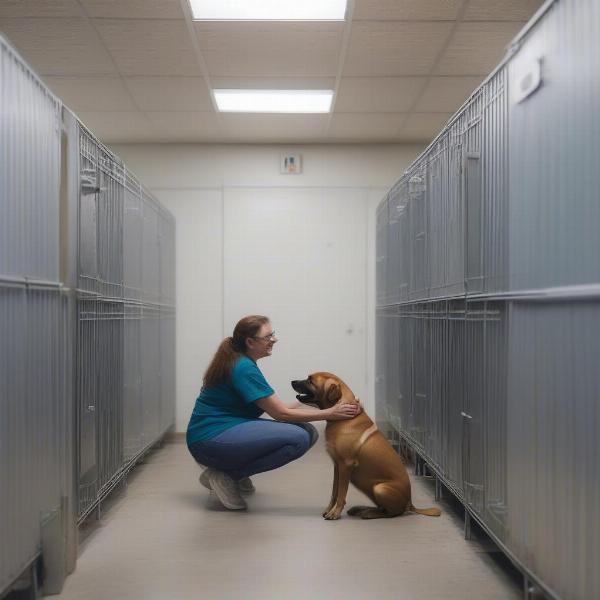Rehoming a dog can be a difficult decision, but sometimes it’s the best option for both the dog and the owner. Whether due to unforeseen circumstances, lifestyle changes, or realizing you’re not equipped to handle the responsibility, finding a new loving home quickly is paramount. This article will guide you through the process of how to rehome a dog fast, prioritizing the dog’s well-being and ensuring a smooth transition.
Understanding the Reasons for Rehoming
Before diving into the rehoming process, take a moment to understand the reasons behind your decision. This introspection will help you communicate the dog’s needs effectively to potential adopters. Common reasons include changes in living situations, allergies, behavioral issues the owner can’t manage, or simply realizing they lack the time and resources to provide proper care. Being honest and upfront about these reasons is crucial.
Preparing Your Dog for Rehoming
Preparing your dog for rehoming involves ensuring they are healthy, well-behaved, and presentable to potential adopters. Gather all veterinary records, including vaccination history and any medical conditions. If your dog isn’t already microchipped, consider getting it done. A well-groomed dog is more appealing, so bathe them, trim their nails, and address any existing skin or coat issues.
Finding the Right New Home
There are several avenues for finding a suitable new home. Reaching out to your network of friends, family, and colleagues can be a good starting point. Leverage social media platforms, local community groups, and online forums dedicated to dog adoption. Contacting reputable rescue organizations and shelters specific to your dog’s breed can also be highly effective. Be prepared to answer questions about your dog’s temperament, energy level, training, and any special needs.
Working with Rescues and Shelters
Rescue organizations and shelters are invaluable resources in the rehoming process. They have established networks and screening processes to ensure dogs are placed in appropriate homes. While some shelters may have limited space, many breed-specific rescues exist, increasing the chances of finding a perfect match. Be prepared to provide detailed information and potentially pay a surrender fee.
 Dog in a rescue shelter
Dog in a rescue shelter
Creating a Compelling Profile
Whether you’re working with a rescue or finding a home independently, a compelling profile is essential. Highlight your dog’s positive qualities, including their personality, training, and any special skills. Use high-quality photos and videos showcasing their best features. Be honest about any behavioral quirks or medical needs. A well-crafted profile will attract potential adopters and increase the chances of a quick and successful placement.
The Handover Process
Once you’ve found a potential new home, arrange a meet-and-greet. This allows the potential adopters to interact with your dog and assess compatibility. Answer their questions honestly and openly. If both parties are happy, finalize the rehoming. Provide the new owners with all necessary documentation, including veterinary records, vaccination certificates, and any medication information. A smooth handover ensures a positive transition for your dog.
What to Do if You Can’t Rehome Your Dog Quickly?
Sometimes, despite your best efforts, rehoming a dog quickly isn’t possible. If you’re facing this situation, consider contacting local dog trainers or behaviorists for assistance with any behavioral issues that might be hindering the process. Explore temporary fostering options to alleviate immediate pressure. Continue networking and promoting your dog’s profile. Don’t give up – the right home is out there.
Conclusion
Rehoming a dog can be an emotional experience, but by following these steps, you can ensure your dog finds a loving and suitable new home quickly. Remember to prioritize your dog’s well-being throughout the process, be honest and transparent with potential adopters, and be patient. By taking the right steps, you can give your dog the best chance at a happy and fulfilling life. Rehoming responsibly allows you to focus on finding the perfect fit, not just the fastest solution.
FAQ
- How do I find a reputable rescue organization? Research local rescues online, check their reviews and ratings, and contact them directly to inquire about their adoption process.
- What should I do if my dog has behavioral issues? Consult a certified dog trainer or behaviorist to address the issues before rehoming.
- Is it okay to ask for a rehoming fee? Yes, a reasonable rehoming fee can help deter irresponsible adopters.
- What information should I provide to the new owner? All veterinary records, vaccination certificates, microchip information, and details about diet, exercise routine, and any behavioral quirks.
- How can I ensure my dog adjusts to their new home? Provide the new owner with familiar items like bedding or toys, and maintain a consistent routine during the initial transition period.
- What if I can’t find a new home for my dog? Explore long-term fostering or sanctuary options. Never abandon your dog.
- How can I cope with the emotional aspect of rehoming? Remember you’re making the best decision for your dog’s well-being. Seek support from friends, family, or a therapist.
About ILM Dog: ILM Dog is your trusted international resource for expert dog care advice, covering everything from breed selection and health to training and nutrition. We connect dog owners worldwide with practical, reliable information and resources to enhance the well-being of their canine companions. For expert guidance on all aspects of dog care, contact us at [email protected] or call +44 20-3965-8624.